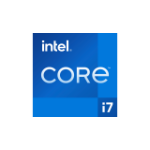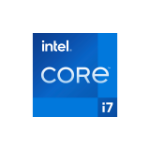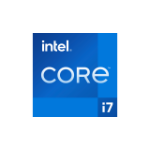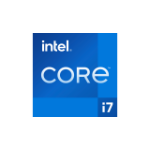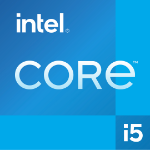Demystifying the Choice: Intel® Core™ i5 vs. i7 Processors for Business IT Equipment (2024)
Intel® Core™ processors represent a range of CPUs designed to cater to various computing needs. Both i5 and i7 processors are powerful options for business environments, but they cater to different levels of processing intensity.Intel®
Core™ i5 Processors: These processors balance performance and affordability, making them ideal for everyday business tasks such as web browsing, document editing, video conferencing, and email management. They are a popular choice for mainstream business desktops and laptops employees use for productivity applications.
Intel® Core™ i7 Processors: These processors deliver top-tier performance, excelling in demanding workloads like data analysis, complex calculations, video editing, and multitasking with memory-intensive applications. They are well-suited for high-performance business desktops and laptops used by professionals like graphic designers, engineers, and data analysts.
Key Differences Between i5 and i7 Processors
Here's a breakdown of the key factors that differentiate Intel® Core™ i5 and i7 processors for business IT equipment:
Cores and Threads:
Core Count: Both i5 and i7 processors come with at least four cores (quad-core). However, some higher-end i7 models boast six or eight cores (hexa-core or octa-core), allowing them to handle more complex tasks by running multiple programs simultaneously. This can be particularly beneficial for multitasking and running resource-intensive applications.
HyperThreading Technology: Both processor families often incorporate Intel® HyperThreading Technology. This technology enables each core to handle two threads simultaneously, effectively doubling the processing power and improving multitasking efficiency. However, some high-end i7 models may offer more threads compared to i5 processors.
Clock Speed:
Clock speed refers to the number of cycles a processor can complete per second, measured in GHz (gigahertz). While both i5 and i7 processors offer competitive base clock speeds, i7 models often boast higher maximum turbo frequencies with Intel® Turbo Boost Technology. This allows them to dynamically increase clock speed when handling demanding tasks, resulting in faster processing.
Cache Memory:
Cache memory acts as a temporary storage space for frequently accessed data, significantly impacting overall system performance. Both i5 and i7 processors come with cache memory, but i7 models typically have a larger L3 cache. This larger cache allows them to store more data readily available for processing, leading to faster response times and improved performance in applications that rely heavily on data access.
Integrated Graphics:
Many Intel® Core™ processors come equipped with integrated graphics capabilities. These integrated graphics handle basic visual tasks like displaying emails and web pages. While not ideal for demanding graphics applications, they can be sufficient for most business needs.
However, some higher-end i7 models may feature more powerful integrated graphics, providing a slight edge for tasks like video conferencing or basic video editing. Businesses with employees requiring advanced graphics capabilities, however, should consider a dedicated graphics card alongside the processor.
Price:
As a general rule, Intel® Core™ i7 processors carry a higher price tag due to their increased processing power and features. However, the specific cost will vary depending on the generation, model, and specific features of the processor.
Choosing the Right Processor for Your Business
Now that you grasp the core differences between Intel® Core™ i5 and i7 processors, let's explore how to choose the right option for your business needs:
Consider Your Workload: Identify the primary applications your employees will use. If their tasks involve basic productivity applications like web browsing, email, and document editing, an i5 processor can be a cost-effective and powerful choice. For professionals.
Key Differences Between i5 and i7 Processors
Here's a breakdown of the key factors that differentiate Intel® Core™ i5 and i7 processors for business IT equipment:
Multitasking Needs:
If your employees frequently juggle multiple programs simultaneously, an i7 processor with its higher core count and HyperThreading technology will offer a significant advantage. This allows for smoother multitasking without experiencing lag or performance bottlenecks.
Future-proofing Your Investment:
If you anticipate your business needs evolving and applications becoming more demanding in the future, opting for an i7 processor might be a wise investment. This provides greater headroom for handling more complex tasks down the line.
Budgetary Constraints:
Cost is always a crucial consideration. While i7 processors offer superior performance, i5 processors deliver excellent value for everyday business tasks. Carefully evaluate your budget and prioritize features most critical for your business needs.
Specific Examples - Matching Processor to Business Needs:
Here are some examples to illustrate how to match processor choice to specific business needs:
Scenario: A company equips its customer service representatives with basic desktop computers primarily used for web browsing, email management, and customer relationship management (CRM) software.
Recommendation:Intel® Core™ i5 processor: This provides ample processing power for these essential business tasks, making it a cost-effective and suitable choice.
Scenario: A design firm employs graphic designers using software like Adobe Photoshop and AutoCAD for complex design projects.
Recommendation: Intel® Core™ i7 processor: With its high core count, HyperThreading, and larger cache, this processor offers faster rendering times and smoother operation with demanding design applications.
Beyond i5 and i7 Processors: Additional Considerations
While i5 and i7 processors are excellent options for most business needs, it's important to consider other factors when selecting IT equipment:
RAM (Random Access Memory): This temporary storage significantly impacts performance. Allocate sufficient RAM (at least 8GB, ideally 16GB or more) for smooth multitasking and responsiveness with business applications.
Storage: Solid-state drives (SSDs) offer significantly faster boot times and application loading compared to traditional hard disk drives (HDDs). Consider SSDs for business laptops and desktops requiring optimal performance.
Security Features: Look for processors with built-in security features like Intel® Trusted Platform Module (TPM) technology. This helps safeguard business data and protects against cyber threats.
Conclusion:
By understanding the core differences between Intel® Core™ i5 and i7 processors and considering your specific business needs, workload demands, and budget, you can make an informed choice when equipping your team with the right processing power for optimal performance and productivity. Remember, there's no one-size-fits-all solution. Evaluate your business requirements thoroughly to ensure you're investing in IT equipment that empowers your workforce and drives success.
Examples of Products with Intel® Core™ Processors:
Here are some specific examples of business desktops and laptops featuring Intel® Core™ processors from Lenovo and HP to illustrate the points discussed:
Scenario: A company equips its customer service representatives with basic desktop computers primarily used for web browsing, email management, and customer relationship management (CRM) software.
Processor Recommendation: Intel® Core™ i5 processor: This provides ample processing power for these essential business tasks. Consider options like the 12th Gen Intel® Core™ i5-12400 or the AMD Ryzen™ 5 series processors offered by Lenovo ThinkCentre desktops and HP EliteDesk desktops. These processors deliver excellent value for everyday business needs.
Scenario: A design firm employs graphic designers using software like Adobe Photoshop and AutoCAD for complex design projects.
Processor Recommendation: Intel® Core™ i7 processor: With its high core count, HyperThreading, and larger cache, this processor offers faster rendering times and smoother operation with demanding design applications. Explore options like the 12th Gen Intel® Core™ i7-12700 or the AMD Ryzen™ 7 series processors available in Lenovo ThinkPad P series mobile workstations and HP ZBook mobile workstations. These processors provide the necessary processing muscle for design professionals.
Important Note:
It's important to remember that this blog focuses on Intel® Core™ processors. However, some business laptops and desktops might offer competitive AMD Ryzen™ processors as well. Evaluate the specific features and performance benchmarks of both processor families before making a decision.
Finding the Perfect Fit:
A variety of business desktops and laptops are available featuring different Intel® Core™ processor options from various brands like Lenovo and HP. Consult with a qualified IT professional or sales representative to determine the ideal processor configuration for your specific business needs. They can help you explore the latest processor options from Intel® Core™ and AMD Ryzen™ families to ensure you equip your team with the optimal processing power for success.
Core™ i5 Processors: These processors balance performance and affordability, making them ideal for everyday business tasks such as web browsing, document editing, video conferencing, and email management. They are a popular choice for mainstream business desktops and laptops employees use for productivity applications.
Intel® Core™ i7 Processors: These processors deliver top-tier performance, excelling in demanding workloads like data analysis, complex calculations, video editing, and multitasking with memory-intensive applications. They are well-suited for high-performance business desktops and laptops used by professionals like graphic designers, engineers, and data analysts.
Key Differences Between i5 and i7 Processors
Here's a breakdown of the key factors that differentiate Intel® Core™ i5 and i7 processors for business IT equipment:
Cores and Threads:
Core Count: Both i5 and i7 processors come with at least four cores (quad-core). However, some higher-end i7 models boast six or eight cores (hexa-core or octa-core), allowing them to handle more complex tasks by running multiple programs simultaneously. This can be particularly beneficial for multitasking and running resource-intensive applications.
HyperThreading Technology: Both processor families often incorporate Intel® HyperThreading Technology. This technology enables each core to handle two threads simultaneously, effectively doubling the processing power and improving multitasking efficiency. However, some high-end i7 models may offer more threads compared to i5 processors.
Clock Speed:
Clock speed refers to the number of cycles a processor can complete per second, measured in GHz (gigahertz). While both i5 and i7 processors offer competitive base clock speeds, i7 models often boast higher maximum turbo frequencies with Intel® Turbo Boost Technology. This allows them to dynamically increase clock speed when handling demanding tasks, resulting in faster processing.
Cache Memory:
Cache memory acts as a temporary storage space for frequently accessed data, significantly impacting overall system performance. Both i5 and i7 processors come with cache memory, but i7 models typically have a larger L3 cache. This larger cache allows them to store more data readily available for processing, leading to faster response times and improved performance in applications that rely heavily on data access.
Integrated Graphics:
Many Intel® Core™ processors come equipped with integrated graphics capabilities. These integrated graphics handle basic visual tasks like displaying emails and web pages. While not ideal for demanding graphics applications, they can be sufficient for most business needs.
However, some higher-end i7 models may feature more powerful integrated graphics, providing a slight edge for tasks like video conferencing or basic video editing. Businesses with employees requiring advanced graphics capabilities, however, should consider a dedicated graphics card alongside the processor.
Price:
As a general rule, Intel® Core™ i7 processors carry a higher price tag due to their increased processing power and features. However, the specific cost will vary depending on the generation, model, and specific features of the processor.
Choosing the Right Processor for Your Business
Now that you grasp the core differences between Intel® Core™ i5 and i7 processors, let's explore how to choose the right option for your business needs:
Consider Your Workload: Identify the primary applications your employees will use. If their tasks involve basic productivity applications like web browsing, email, and document editing, an i5 processor can be a cost-effective and powerful choice. For professionals.
Key Differences Between i5 and i7 Processors
Here's a breakdown of the key factors that differentiate Intel® Core™ i5 and i7 processors for business IT equipment:
Multitasking Needs:
If your employees frequently juggle multiple programs simultaneously, an i7 processor with its higher core count and HyperThreading technology will offer a significant advantage. This allows for smoother multitasking without experiencing lag or performance bottlenecks.
Future-proofing Your Investment:
If you anticipate your business needs evolving and applications becoming more demanding in the future, opting for an i7 processor might be a wise investment. This provides greater headroom for handling more complex tasks down the line.
Budgetary Constraints:
Cost is always a crucial consideration. While i7 processors offer superior performance, i5 processors deliver excellent value for everyday business tasks. Carefully evaluate your budget and prioritize features most critical for your business needs.
Specific Examples - Matching Processor to Business Needs:
Here are some examples to illustrate how to match processor choice to specific business needs:
Scenario: A company equips its customer service representatives with basic desktop computers primarily used for web browsing, email management, and customer relationship management (CRM) software.
Recommendation:Intel® Core™ i5 processor: This provides ample processing power for these essential business tasks, making it a cost-effective and suitable choice.
Scenario: A design firm employs graphic designers using software like Adobe Photoshop and AutoCAD for complex design projects.
Recommendation: Intel® Core™ i7 processor: With its high core count, HyperThreading, and larger cache, this processor offers faster rendering times and smoother operation with demanding design applications.
Beyond i5 and i7 Processors: Additional Considerations
While i5 and i7 processors are excellent options for most business needs, it's important to consider other factors when selecting IT equipment:
RAM (Random Access Memory): This temporary storage significantly impacts performance. Allocate sufficient RAM (at least 8GB, ideally 16GB or more) for smooth multitasking and responsiveness with business applications.
Storage: Solid-state drives (SSDs) offer significantly faster boot times and application loading compared to traditional hard disk drives (HDDs). Consider SSDs for business laptops and desktops requiring optimal performance.
Security Features: Look for processors with built-in security features like Intel® Trusted Platform Module (TPM) technology. This helps safeguard business data and protects against cyber threats.
Conclusion:
By understanding the core differences between Intel® Core™ i5 and i7 processors and considering your specific business needs, workload demands, and budget, you can make an informed choice when equipping your team with the right processing power for optimal performance and productivity. Remember, there's no one-size-fits-all solution. Evaluate your business requirements thoroughly to ensure you're investing in IT equipment that empowers your workforce and drives success.
Examples of Products with Intel® Core™ Processors:
Here are some specific examples of business desktops and laptops featuring Intel® Core™ processors from Lenovo and HP to illustrate the points discussed:
Scenario: A company equips its customer service representatives with basic desktop computers primarily used for web browsing, email management, and customer relationship management (CRM) software.
Processor Recommendation: Intel® Core™ i5 processor: This provides ample processing power for these essential business tasks. Consider options like the 12th Gen Intel® Core™ i5-12400 or the AMD Ryzen™ 5 series processors offered by Lenovo ThinkCentre desktops and HP EliteDesk desktops. These processors deliver excellent value for everyday business needs.
Scenario: A design firm employs graphic designers using software like Adobe Photoshop and AutoCAD for complex design projects.
Processor Recommendation: Intel® Core™ i7 processor: With its high core count, HyperThreading, and larger cache, this processor offers faster rendering times and smoother operation with demanding design applications. Explore options like the 12th Gen Intel® Core™ i7-12700 or the AMD Ryzen™ 7 series processors available in Lenovo ThinkPad P series mobile workstations and HP ZBook mobile workstations. These processors provide the necessary processing muscle for design professionals.
Important Note:
It's important to remember that this blog focuses on Intel® Core™ processors. However, some business laptops and desktops might offer competitive AMD Ryzen™ processors as well. Evaluate the specific features and performance benchmarks of both processor families before making a decision.
Finding the Perfect Fit:
A variety of business desktops and laptops are available featuring different Intel® Core™ processor options from various brands like Lenovo and HP. Consult with a qualified IT professional or sales representative to determine the ideal processor configuration for your specific business needs. They can help you explore the latest processor options from Intel® Core™ and AMD Ryzen™ families to ensure you equip your team with the optimal processing power for success.
Posted:
March 08, 2024
|

